Cascade Range
| Cascade Range | |
|---|---|
| Cascade Mountains (in Canada) "The Cascades" | |
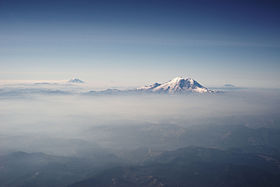 The Cascades in Washington, withMount Rainier,the range's highest mountain, standing at 14,411 ft (4,392 m). Seen in the background (left to right) areMount Adams,Mount Hood,andMount St. Helens. | |
| Highest point | |
| Peak | Mount Rainier,Washington |
| Elevation | 14,411 ft (4,392 m)NAVD 88[1] |
| Coordinates | 46°51′10″N121°45′38″W/ 46.8528267°N 121.7604408°W[2] |
| Dimensions | |
| Length | 700 mi (1,100 km) north-south |
| Width | 80 mi (130 km) |
| Geography | |
| Countries | United States and Canada |
| Provinces/States | British Columbia,Washington,Oregon,andCalifornia |
TheCascade RangeorCascadesis a majormountain rangeof westernNorth America,extending from southernBritish ColumbiathroughWashingtonandOregontoNorthern California.It includes both non-volcanic mountains, such as many of those in theNorth Cascades,and the notablevolcanoesknown as theHigh Cascades.The small part of the range in British Columbia is referred to as theCanadian Cascadesor, locally, as theCascade Mountains.The highest peak in the range isMount Rainierin Washington at 14,411 feet (4,392 m).
The Cascades arepart of thePacific Ocean'sRing of Fire,the ring of volcanoes and associated mountains around the Pacific Ocean. All of the eruptions in thecontiguous United Statesover the last 200 years have been fromCascade volcanoes.The two most recent wereLassen Peakfrom 1914 to 1921 and amajor eruption of Mount St. Helens in 1980.Minor eruptions of Mount St. Helens have also occurred since, most recently from 2004 to 2008.[3]The Cascade Range is a part of theAmerican Cordillera,a nearly continuous chain of mountain ranges (cordillera) that form the western "backbone" of North,Central,andSouth America.
The Cascades are home to many national parks and protected areas, includingNorth Cascades National Park,Mount Rainier National Park,Crater Lake National Park,andLassen Volcanic National Park.The northern half of thePacific Crest Trailfollows the range.
Geography[edit]

The Cascades extend northward fromLassen Peak(also known as Mount Lassen) in northernCaliforniato the confluence of theNicolaandThompsonrivers inBritish Columbia.TheFraser Riverseparates the Cascades from theCoast Mountainsin Canada,[4]as does theWillamette Valleyfrom the upper portion of theOregon Coast Range.The highest volcanoes of the Cascades, known as the High Cascades,[5]dominate their surroundings, often standing twice the height of the nearby mountains. They often have a visual height (height above nearby crestlines) of one mile or more. The highest peaks, such as the 14,411-foot (4,392 m) Mount Rainier, dominate their surroundings for 50 to 100 miles (80 to 161 km).
The northern part of the range, north of Mount Rainier, is known as theNorth Cascadesin the United States but is formally named the Cascade Mountains north of theCanada–United States border,reaching to the northern extremity of the Cascades atLytton Mountain.[6]Overall, the North Cascades and Canadian Cascades are extremely rugged; even the lesser peaks are steep and glaciated, and valleys are quite low relative to peaks and ridges, so there is great localrelief.[7]The southern part of the Canadian Cascades, particularly theSkagit Range,is geologically and topographically similar to the North Cascades, while the northern and northeastern parts are less glaciated and more plateau-like, resembling nearby areas of theThompson Plateau.[4]
The range is near the Pacific Ocean and in the region'sprevailing westerly winds,so it receives significant rain and snowfall, especially on the western slopes due toorographic lift,with annual snow accumulations of up to 1,000 inches (2,500 cm) (= 83 feet (25 m)) in some areas.Mount Bakerin Washington recorded a national record single-season snowfall in the winter of 1998–99 with 1,140 inches (2,900 cm) (= 95 feet (29 m)).[8]Before that year,Mount Rainierheld the American record for snow accumulation at Paradise in 1978. It is not uncommon for some places in the Cascades to have over 500 inches (1,300 cm) of annual snow accumulation, such as atLake Helen,near Lassen Peak.[9]Most of the High Cascades are therefore white with snow and ice year-round. The western slopes are densely covered withDouglas-fir(Pseudotsuga menziesii),western hemlock(Tsuga heterophylla) andred alder(Alnus rubra),[10]while the drier eastern slopes feature mostlyponderosa pine(Pinus ponderosa), with somewestern larch(Larix occidentalis),mountain hemlock(Tsuga mertensiana) andsubalpine fir(Abies lasiocarpa) andsubalpine larch(Larix lyallii) at higher elevations.[11]Annual rainfall is as low as 9 inches (230 mm) on the easternfoothillsdue to arain shadoweffect.[12]
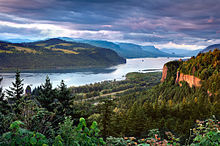
Beyond the eastern foothills is anaridplateau that was largely formed 17 to 14 million years ago by the many flows of theColumbia River Basalt Group.Together, these sequences of fluidvolcanic rockform the 200,000-square-mile (520,000 km2)Columbia Plateauin eastern Washington, Oregon, and parts of western Idaho.[13]
TheColumbia River Gorgeis the only major break of the range in the United States. When the Cascades began to rise 7 million years ago in the lateMiocene,the Columbia River drained the relatively low Columbia Plateau. As the range grew, erosion from the Columbia River was able to keep pace, carving out the gorge and major pass seen today. The gorge also exposes uplifted and warped layers of basalt from the plateau.[14][15]
History[edit]
Before European exploration, First Nations tribes named many peaks, including "Wy'east" forMount Hood,[16]"Seekseekqua" forMount Jefferson (Oregon),[16]"M'laiksini Yaina" forMount McLoughlin,[16]"Tahoma", theLushootseedname for Mount Rainier,[17]and "Louwala-Clough", meaning "smoking mountain" for Mount St. Helens.[18]
In early 1792, British navigatorGeorge VancouverexploredPuget Soundand gave English names to the high mountains he saw. Mount Baker was named for Vancouver's third lieutenant,Joseph Baker,although the first European to see it wasManuel Quimper,who named itla gran montaña del Carmelo( "GreatMount Carmel") in 1790.[19]Mount Rainier was named after AdmiralPeter Rainier.Later in 1792, Vancouver had his lieutenantWilliam Robert Broughtonexplore the lowerColumbia River.He namedMount HoodafterLord Samuel Hood,anadmiralof theRoyal Navy.Mount St. Helenswas sighted by Vancouver in May 1792, from near the mouth of the Columbia River. It was named forAlleyne FitzHerbert, 1st Baron St Helens,a British diplomat.[20]Vancouver's expedition did not, however, name the mountain range which contained these peaks. He referred to it simply as the "eastern snowy range". Earlier Spanish explorers called itSierra Nevada,meaning "snowy mountains".[19]
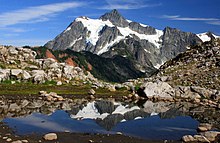
In 1805, theLewis and Clark Expeditionpassed through the Cascades on the Columbia River, which for many years was the only practical way to pass that part of the range. They were the first non-indigenous people to seeMount Adams,but they thought it was Mount St. Helens. When they later saw Mount St. Helens they thought it was Mount Rainier.[21]On their return trip, Lewis and Clark spotted ahigh but distant snowy pinnaclethat they named for the sponsor of the expedition, U.S. PresidentThomas Jefferson.[22]Lewis and Clark called the Cascade Range the "Western Mountains".[23]
The Lewis and Clark expedition, and the many settlers and traders that followed, met their last obstacle to their journey at theCascades Rapidsin the Columbia River Gorge, a feature on the river now submerged beneath theBonneville Reservoir.Before long, the great white-capped mountains that loomed above the rapids were called the "mountains by the cascades" and later simply as the "Cascades". The earliest attested use of the name "Cascade Range" is in the writings of botanistDavid Douglasin 1825.[24][25]

In 1814,Alexander Ross,a fur trader with theNorth West Company,seeking a viable route across the mountains, explored and crossed the northern Cascades betweenFort Okanoganand Puget Sound. His report of the journey is vague about the route taken. He followed the lowerMethow Riverinto the mountains. He might have usedCascade Passto reach theSkagit River.Ross was the first European-American to explore the Methow River area and likely the first to explore theStehekin Riverand Bridge Creek region. Due to the difficulty of crossing the northern Cascades and the paucity of beaver, fur-trading companies made only a few explorations into the mountains north of the Columbia River after Ross.[26]
Exploration and settlement of the Cascades region by Europeans and Americans was accelerated by the establishment of a major trading post of theHudson's Bay Company(HBC) atFort Vancouvernear today'sPortland, Oregon.From this base HBC trapping parties traveled throughout the Cascades in search of beaver and other fur-bearing animals. For example, using what became known as theSiskiyou Trail,Hudson's Bay Company trappers were the first non-natives to explore the southern Cascades in the 1820s and 1830s, establishing trails which passed nearCrater Lake,Mount McLoughlin,Medicine Lake Volcano,Mount Shasta,and Lassen Peak.[27]
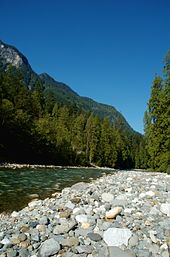
The course of political history in thePacific Northwestsaw the spine of the Cascade Range being proposed as a boundary settlement during theOregon Disputeof 1846. The United States rejected the proposal and insisted on the49th parallel north,which cuts across the range just north of Mount Baker. Throughout the period of dispute and up to the creation of theCrown Colonyof British Columbia in 1858, the Hudson's Bay Company'sYork Factory Expressroute, as well the route of fur brigades, followed the Okanogan River along the east edge of the Cascades and the Columbia River through the range. Passes across the range were not well known and little used.Naches Passwas used for driving cattle and horses toFort Nisqually.Yakima Passwas also used by the Hudson's Bay Company.[28]
American settlement of the flanks of the Coast Range did not occur until the early 1840s, at first only marginally. Following theOregon Treatythe inward flux of migration from theOregon Trailintensified and the passes and back-valleys of what is now the state of Washington were explored and populated, and it was not long after that railways followed. Despite its being traversed by several major freeways and rail lines, and its lower flanks subjected to major logging in recent decades, large parts of the range remain intense and forbidding alpine wilderness. Much of the northern half of the Cascades, from Rainier north, have been preserved byU.S. nationalor British Columbiaprovincial parks(such asE.C. Manning Provincial Park), or other forms of protected area.[29]
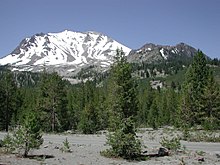
The Canadian side of the range has a history that includes theFraser Canyon Gold Rushof 1858–60 and its famousCariboo Road,as well as the older Hudson's Bay Company Brigade Trail from the Canyon to the Interior, the Dewdney Trail, and older routes which connected east to theSimilkameenandOkanaganvalleys.
The southern mainline of theCanadian Pacific Railwaypenetrated the range via the passes of theCoquihalla River,along one of the steepest and snowiest routes in the entirePacific Cordillera.NearHope, B.C.,therailway roadbedand theOthello Tunnels,now decommissioned, are popular tourist recreation destinations for hiking and bicycling. The pass is used by theCoquihalla Highway,a governmentmegaprojectbuilt as part of theExpo 86spending boom of the 1980s, which is now the main route from the Coast to the British Columbia interior. Traffic formerly went via theFraser Canyon,to the west, or viaAllison PassandManning ParkalongHighway 3to the south, near the border.
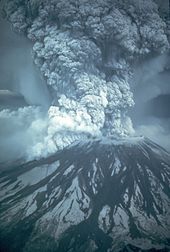
TheBarlow Roadwas the first established land path for U.S. settlers through the Cascade Range in 1845, and formed the final overland link for theOregon Trail(previously, settlers had to raft down thetreacherous rapidsof the Columbia River). The Road left the Columbia at what is nowHood Riverand passed along the south side of Mount Hood at what is nowGovernment Camp,terminating in Oregon City. There is an interpretive site there now at "The End of The Oregon Trail". The road was constructed as a toll road – $5 per wagon – and was very successful.
In addition, theApplegate Trailwas created to allow settlers to avoid rafting down the Columbia River. The Trail used the path of theCalifornia Trailto north-centralNevada.From there, the Trail headed northwest into northern California, and continued northwest towards today'sAshland, Oregon.From there, settlers would head north along the established Siskiyou Trail into theWillamette Valley.
With the exception of the 1915 eruption of remote Lassen Peak in Northern California, the range was quiet for more than a century. Then, on May 18, 1980, the dramatic eruption ofMount St. Helensshattered the quiet and brought the world's attention to the range. Geologists were also concerned that the St. Helens eruption was a sign that long-dormant Cascade volcanoes might become active once more, as in the period from 1800 to 1857 when a total of eight erupted. None have erupted since St. Helens, but precautions are being taken nevertheless, such as theCascades Volcano Observatoryand Mount Rainier VolcanoLaharWarning System inPierce County, Washington.[30]
Geology[edit]

The Cascade Range is made up of a band of thousands of very small, short-lived volcanoes that have built a platform of lava and volcanic debris. Rising above this volcanic platform are a few strikingly large volcanoes, like Mount Hood and Mount St. Helens, that dominate the landscape.[31]
The Cascade volcanoes define the Pacific Northwest section of theRing of Fire,an array of volcanoes that rim the Pacific Ocean. The Ring of Fire is also known for its frequent earthquakes. The volcanoes and earthquakes arise from a common source:subduction,where the denseJuan de Fuca oceanic plateplunges beneath theNorth American Plate.[32]As theoceanic slabsinks deep into the Earth's interior beneath the continental plate, high temperatures and pressures allow water molecules locked in the minerals of solid rock to escape. The water vapor rises into the pliable mantle above the subducting plate, causing some of the mantle to melt. This newly formed magma rises toward the Earth's surface to erupt, forming a chain of volcanoes (the Cascade Volcanic Arc) above the subduction zone.[32]
Human uses[edit]
Soil conditions for farming are generally good, especially downwind ofvolcanoes.This is largely because volcanic rocks are often rich inpotassium-bearing minerals such asorthoclase,and erode relatively easily. Volcanic debris, especiallylahars,also helps to spread mineral-rich volcanic material, and the storage of water in the form of snow and ice is also important for agriculture. The snow-capped mountains, such as Mt. Hood andMt. Bachelor,are used asski resortsin the late winter, while in the summer they become popularhikingandmountaineeringlocations. Much of their meltwater eventually flows into reservoirs, where it is used for recreation, while its potential energy is captured to generatehydroelectric powerbefore the water is used toirrigatecrops.
Because of the abundance of powerful streams, many of the major westward-draining rivers of the Cascades have been dammed to providehydroelectric power.One of these,Ross Damon theSkagit River,retains a reservoir which spans the border southeast ofHope, British Columbia,extending 2 miles (3.2 km) into Canada. At the foot of the southeast flank of Mount Baker, atConcrete, Washington,theBaker Riveris dammed to formLake ShannonandBaker Lake.
The Cascades harbor a largely-untapped potential forgeothermal power.TheU.S. Geological SurveyGeothermal Research Program has been investigating this potential. Some of this energy is already being used in places likeKlamath Falls, Oregon,where volcanic steam is used to heat public buildings.[33]The highest recorded underground temperature found in the range is 510 °F (266 °C) at 3,075 feet (937 m) belowNewberry Volcano'scalderafloor.
Ecology[edit]
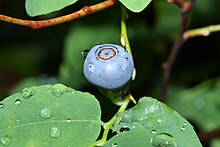
Forests of large, coniferous trees (western red cedars,Douglas-firs, western hemlocks,firs,pines,spruces,and others) dominate most of the Cascade Range. Cool, wet winters and warm, dry summers (largely a result of oceanic influence) favor evergreen species, whereas mild temperatures and rich soils promote fast and prolonged growth.[34][35]

As a traveler passes through the Cascade Range, the climate first gets colder, then warmer and drier east of the crest.[36]Most of the Cascades' lower and middle elevations are covered inconiferous forest;the higher altitudes have extensivemeadowsas well asalpine tundraandglaciers.The southern part of the Cascades are within theCalifornia Floristic Province,an area of highbiodiversity.[citation needed]
Silver firpredominates above 2500 ft, while there aremoors,meadows,andmountain hemlock/subalpine firgroves from 4500 to 6000 ft on the west side. Thetreelineis at ~6000 feet. On the east side, subalpine forests oflarchtrees grade topineand interiorfirforests below 4200 ft, which grade toponderosabelow 2500 ft, which in turn grades to semidesertscrubnear sea level. Above 7500 ft, the landscape is barren with either no plants or onlymossandlichen.[37]
Black bears,coyotes,bobcats,cougars,beavers,deer,elk,moose,mountain goatsand a fewwolfpacks returning from Canada live in the Cascades. Fewer than 50grizzly bearsreside in the Cascades of Canada and Washington.[38]
See also[edit]
References[edit]
- Citations
- ^"Topographic map of Mount Rainier".opentopomap.org.Retrieved2023-05-08.
- ^"Mount Rainier".Geographic Names Information System.United States Geological Survey,United States Department of the Interior.Retrieved2023-05-08.
- ^"Mount St. Helens: 2004–2008 Renewed Volcanic Activity".Cascades Volcano Observatory.U.S. Geological Survey. February 7, 2013. Archived fromthe originalon April 28, 2015.RetrievedNovember 9,2013.
- ^abBeckey 2008,pp. 191–200.
- ^Martin 2002,p. 31.
- ^Duffell & McTaggart 1951,p. 8.
- ^Beckey 2003,pp. 9–12.
- ^"National Climate Extremes".National Oceanic and Atmospheric Administration. Archived fromthe originalon June 6, 2012.
- ^McLaughlin, Mark (October 14, 2010)."Weather Window: The snowiest spot in California is Lake Helen near Lassen Volcanic National Park".Sierra Sun.Truckee, California.RetrievedNovember 9,2013.
- ^Beckey 2008,p. 16.
- ^Mueller & Mueller 2002,p. 99.
- ^Ernst 2000,p. 479.
- ^Straub, Kristen; Link, Paul."Columbia River Basalt Province".Digital Geology of Idaho.Idaho State University. Archived fromthe originalon October 23, 2013.RetrievedNovember 3,2013.
- ^Harrison, John (October 31, 2008)."Columbia River Gorge".Columbia River History.Northwest Power and Conservation Council.RetrievedNovember 9,2013.
- ^"The Cascade Episode: Evolution of the Modern Pacific Northwest".Burke Museum of Natural History and Culture, University of Washington.RetrievedNovember 9,2013.
- ^abcHale, Jamie (17 May 2019),"The native names of Pacific Northwest mountains",The Oregonian,retrieved25 October2021
- ^"Mount Rainier, Washington".Naming the Cascade Range Volcanoes.U.S. Geological Survey.RetrievedApril 23,2012.
- ^"Northwest Legends".Mount St. Helens Volcano, Washington.U.S. Geological Survey. Archived fromthe originalon May 10, 2012.
- ^abBeckey 2003,pp. 3–7.
- ^"Naming the Cascade Range Volcanoes: Mount St. Helens, Washington".U.S. Geological Survey.RetrievedJune 15,2012.
- ^Beckey 2003,pp. 38–39.
- ^"The Volcanoes of Lewis and Clark, Mount Jefferson, Oregon".U.S. Geological Survey.RetrievedJune 15,2012.
- ^Beckey 2003,p. 28.
- ^Beckey 2003,p. 48.
- ^Majors, Harry M. (1975).Exploring Washington.Van Winkle Publishing Co. p. 150.ISBN978-0-918664-00-6.
- ^Beckey 2003,pp. 41–45.
- ^"Museum of the Siskiyou Trail".Archived fromthe originalon April 15, 2012.
- ^Beckey 2003,pp. 63–64, 98.
- ^"North Cascades Ecoregion".Land Scope America.RetrievedJune 15,2012.
- ^"Pilot Project – Mount Rainier Volcano Lahar Warning System".Volcano Hazards Program.U.S. Geological Survey. Archived fromthe originalon May 11, 2008.
- ^
 This article incorporatespublic domain materialfromPacific – Cascades Volcanic Province.United States Geological Survey.
This article incorporatespublic domain materialfromPacific – Cascades Volcanic Province.United States Geological Survey.
- ^ab
 This article incorporatespublic domain materialfromPacific – Cascades Volcanic Province.United States Geological Survey.
This article incorporatespublic domain materialfromPacific – Cascades Volcanic Province.United States Geological Survey.
- ^"Geothermal Utility".City of Klamath Falls. Archived fromthe originalon October 6, 2010.
- ^
 This article incorporatespublic domain materialfrom"Pacific Northwest"(PDF).Status and Trends of the Nation's Biological Resources.
This article incorporatespublic domain materialfrom"Pacific Northwest"(PDF).Status and Trends of the Nation's Biological Resources.
- ^Waring, RH; Franklin, JF (1979). "Evergreen coniferous forests of the Pacific Northwest".Northwest Science.204(4400): 1380–1386.Bibcode:1979Sci...204.1380W.doi:10.1126/science.204.4400.1380.PMID17814182.S2CID28313427.
- ^"Ecoregions of Western Washington and Oregon"(PDF).U.S. Environmental Protection Agency. Archived fromthe original(PDF)on 2017-05-25.RetrievedNovember 4,2013.
- ^"Life Zones in Washington".
- ^Rice, Nathan (November 14, 2011)."The forgotten North Cascades grizzly bear".High Country News.Paonia, Colorado.
- Sources
- Beckey, Fred W. (2003).Range of Glaciers: the Exploration and Survey of the Northern Cascade Range.Portland, Oregon: Oregon Historical Society Press.ISBN978-0-87595-243-7.
- Beckey, Fred W. (2008).Cascade Alpine Guide: Climbing and High Routes Rainy Pass to Fraser River.Seattle, Washington: The Mountaineers Books.ISBN978-1-59485-136-0.
- Duffell, Stanley; McTaggart, Kenneth Cunningham (1951).Ashcroft Map-Area, British Columbia.Memoir (Geological Survey of Canada). Vol. 262. Ottawa, Ontario: Natural Resources Canada; E. Cloutier, King's Printer.OCLC3333133.
- Dzurisin, Dan; Stauffer, Peter H.; Hendley, James W. II (2000) [1997].Living With Volcanic Risk in the Cascades.U.S. Geological Survey.
- Ernst, Wallace Gary (2000).Earth Systems: Processes and Issues.Cambridge, England: Cambridge University Press.ISBN978-0-521-47323-1.
- Harris, Stephen L. (2005).Fire Mountains of the West: The Cascade and Mono Lake Volcanoes(3rd ed.). Missoula, Montana: Mountain Press Publishing Company.ISBN978-0-87842-511-2.
- Holland, Stuart S. (1976).Landforms of British Columbia: A Physiographic Outline (Bulletin 48).British Columbia Department of Mines and Petroleum Resources. Archived fromthe originalon May 4, 2005.
- Martin, James (2002).North Cascades Crest: Notes and Images from America's Alps.Seattle, Washington: Sasquatch Books.ISBN978-1-57061-140-7.
- Mueller, Marge; Mueller, Ted (2002).Exploring Washington's Wild Areas(2nd ed.). Seattle, Washington: The Mountaineers Books.ISBN978-0-89886-807-4.
- Wood, Charles A.; Kienle, Jürgen, eds. (1990).Volcanoes of North America.Cambridge, England: Cambridge University Press.ISBN978-0-521-43811-7.
External links[edit]
- Central and Southern Cascades Forests images at bioimages.vanderbilt.edu
- Eastern Cascades Forests images at bioimages.vanderbilt.edu
- Cascade Mountains Leeward Forests images at bioimages.vanderbilt.edu
- British Columbia Mainland Coastal Forests images at bioimages.vanderbilt.edu
- University of Washington Libraries Digital Collections – Dwight Watson Photographs
- Cascade Range
- Geologic provinces of California
- Geologic provinces of the United States
- Mountain ranges of British Columbia
- Mountain ranges of Northern California
- Mountain ranges of Oregon
- Mountain ranges of Washington (state)
- North American Cordillera
- Pacific Coast Ranges
- Physiographic sections
- Regions of Oregon
